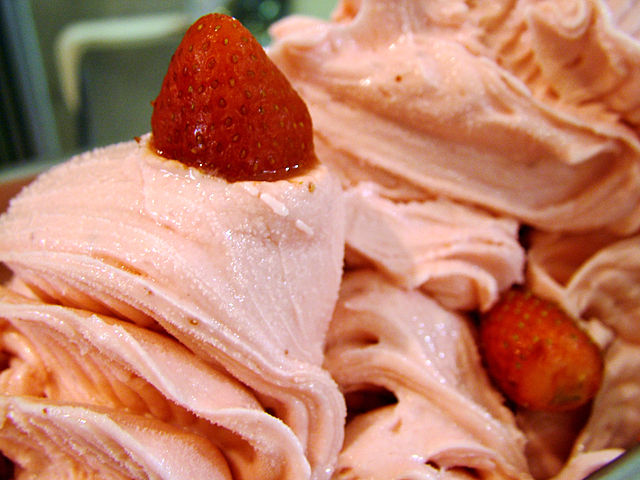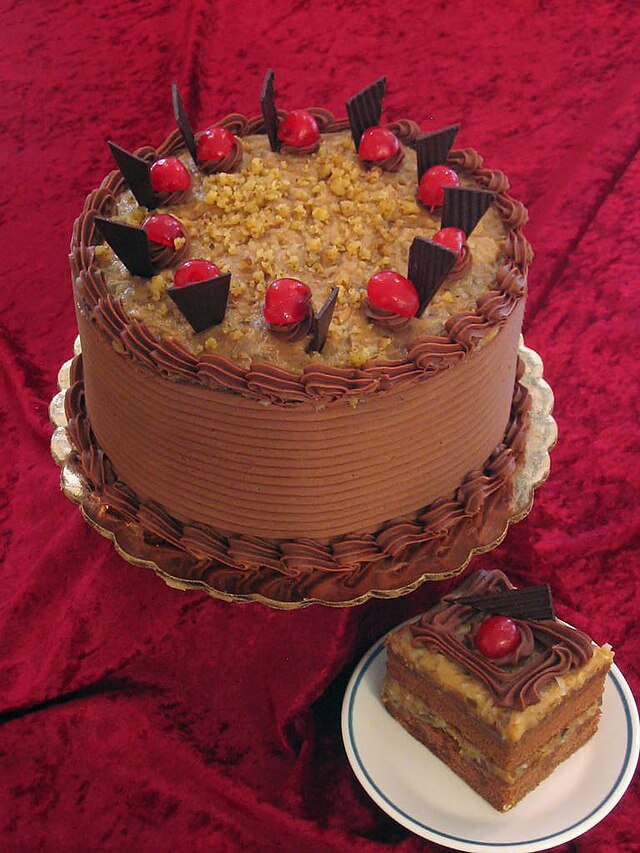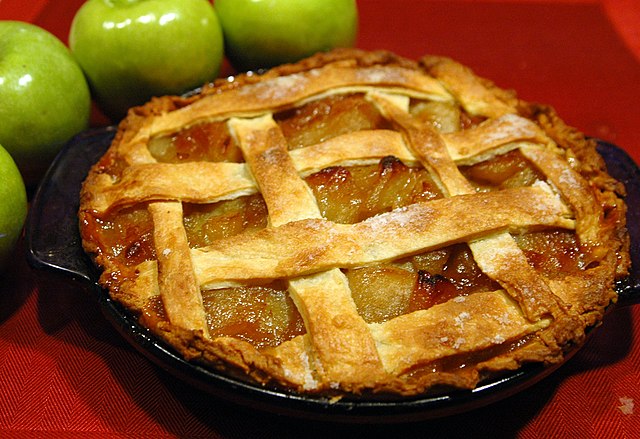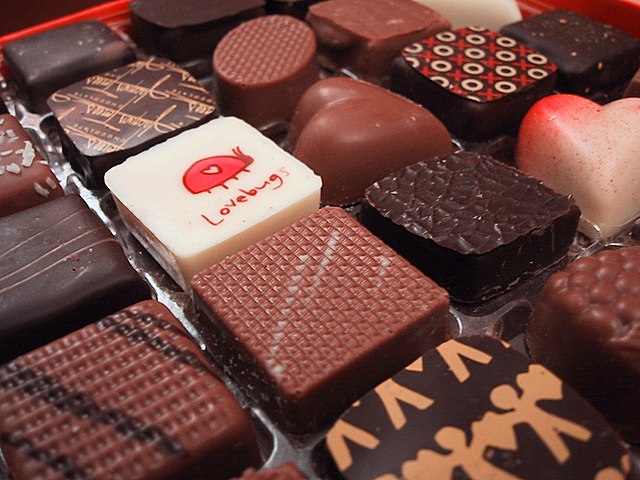Loading AI tools
Hi Wikipedia Users!
 | This is the user sandbox of Mkt324. A user sandbox is a subpage of the user's user page. It serves as a testing spot and page development space for the user and is not an encyclopedia article. Create or edit your own sandbox here. Other sandboxes: Main sandbox | Template sandbox Finished writing a draft article? Are you ready to request review of it by an experienced editor for possible inclusion in Wikipedia? Submit your draft for review! |
Dessert is the usually sweet course that concludes a meal. The food that composes the dessert course includes but is not limited to sweet foods. There is a wide variety of desserts in western cultures now including cakes, cookies, biscuits, gelatins, pastries, ice creams, pies, pudding, and candies. Fruit is also commonly found in dessert courses because of its natural sweetness. Many different cultures have their own variations of similar desserts around the world, such as in Russia, where many breakfast foods such as blint, oladi, and syrniki can be served with honey and jam to make them popular as desserts. The loosely defined course called dessert can apply to many foods[1] .
Etymology
The word dessert originated from the French word desservir “to clean the table” and the negative of the Latin word servire[2].
Usage
The word dessert is most commonly used for this course in the United States, Canada, Australia, and Ireland, while "pudding" or, informally, "sweet" or "afters" are alternative terms that may also be used in the United Kingdom and some other Commonwealth countries, including New Zealand and India[3].
History

Desserts were first made by natural ingredients that were available[1] . In ancient civilizations people enjoyed dried fruits, honeycomb, or nuts.[1] These were considered the first candies. When sugar began to be manufactured in the Middle Ages more sweet desserts became available. Even then sugar was so expensive usually only the wealthy could indulge on special occasions. Ice cream can be dated back to the 3000BC and may be considered as the “dessert” in the modern sense of the word. The first apple pie recipe was printed in 1381. Also 1740 the first cupcake recipes were corded. Ice cream was a Chinese invention although Marco Polo expanded the technique to Europe in his travels. By the 1800’s recipes for how to make ice cream were very popular. Vanilla also plays a large role many desserts including ice cream. Vanilla was mostly grown in Mexico where they discovered if the vanilla pod was picked and dried then vanillin was produced which can be sweetened into a dessert on its own[1][unreliable source?].
Desserts are constantly changing with the new techniques and ingredients available at the time or in the area. They have changed from natural candies and nuts to complex souffles and multi-layered cakes. Many people work with only the ingredients available, which affects the range of desserts that can be made in each region. The first desserts required minimal effort or preparation since ancient cultures were more focused on the nutrition in foods in order to survive. Now, however, modern day cultures have more options in the desserts available. Ice Cream went from being a shaved ice substance with flavoring to the dairy based, sweet treat modern children crave[4]. Desserts also went through a major change in manufacturing. The Industrial Revolution in America and Europe changed desserts and food in general because it began to be mass produced, processed, preserved, canned, and packaged. The iconic foods soon became a staple in many households because their availability. Also a major technique of mass produced food storage was freezing foods. These also became very popular starting in the 1920’s when freezing emerged. Also around the 1920’s lunch counters and fast food restaurants were established with increasing popularity. These processed foods became a huge part of many industrialized nations diets. Food has always been different for each culture and area, and regardless of this boom in mass produced processed desserts, they have still represented regional and ethnic cultures. Many countries have desserts and foods distinctive to their nations or region[5]. One example of this is the churro historically from Spain. These sticks of dough are now deep fried and normally filled. They are available all throughout North and South America along with many other areas. They started with Spanish shepherds as a substitute for bread. Now they have been passed through generations and cultures and changed to a sweet confection different for each culture[6].
Ingredients

Desserts usually contain sugar or a sweetening agent. Desserts contain a range of ingredients which makes the end product differ. Some of the more common ingredients in desserts are flour, dairy, eggs, and spices. Sugar gives many desserts their “addictive sweetness”[7] . Sugar also contributes to the moistness of desserts and their tenderness. The flour or starch component in most desserts serves as a protein and gives the dessert structure. Different flours such as All-Purpose Flour or Pastry Flour provide a less rigid gluten network and therefore a different texture. Along with flour desserts may contain a dairy product. The extent to which dairy is used is based on the type of dessert. Desserts like ice cream and puddings have some sort of dairy as their main ingredient, whereas desserts like cakes and cookies only have relatively small amounts. The dairy products in baked goods keep the desserts moist. Many desserts also contain eggs, in order to form custard or to aid in the rising and thickening of a cake-like substance. Egg yolks specifically contribute to the richness of desserts. Egg whites can act as a leavening agent when the proteins uncoil and expand[8] . Desserts can contain many different spices and extracts to add a variety of flavors. One example of this is salt. Salt is added to desserts to balance sweet flavors and create a contrast in flavors. All these ingredients contribute to desserts and make them different[9].
Varieties
Dessert can come in variations of flavors, textures, and looks. Desserts can be defined as a usually sweeter course that concludes a meal[2] . This definition includes a range of courses anywhere from fruits or dried nuts to multi-ingredient cakes and pies. With the many different varieties of desserts the many cultures have different variations. In modern times the variations of desserts have usually been passed down or come from geological regions. This is one cause for the variation of desserts. These are some major categories in which desserts can be placed[10].
Custards and Puddings- These usually include a thickened dairy base. Custards are cooked and thickened with eggs. Baked custards can include crème brulee and flan. Puddings are thickened with starches.

Frozen Desserts- Ice Cream and gelato both fit into this category. Ice cream is a cream based that’s churned as it is frozen to create a creamy consistency. Gelato uses a milk base and has less air than ice cream. Sorbet is made from churned fruit and is not dairy based.

Cakes- Cakes are sweet tender breads because the sugar and delicate flour used. Cakes can even vary from light, airy sponge cakes to dense flourless cakes. Also personal sized cakes have gotten popular in the form of cupcakes and petits fours.

Cookies- Cookies are similar to cakes (the word coming from the Dutch word “kowkje” meaning little cake). Historically cookies were small spoonfuls of cake batter placed in the oven to test the temperature. Cookies can be in many different forms such as layered bars, crispy meringues, and soft chocolate chip cookies.

Pies- Pies and cobblers are a crust with a filling. The crust can be either made from either a pastry or crumbs. The fillings can be anything from fruits to puddings.

Chocolates and Candies- Many candies involve the crystallization of sugar which varies the texture of sugar crystals. Candies can be in many different forms including caramel, marshmallows, and taffy.

Pastries- Pastries can either be light and flaky with an airy texture or unleavened dough with a high fat content. Pastries can be used with fruits, chocolates, or other sweeteners.

Miscellaneous Desserts- Many desserts cannot be categorized such as cheesecake. It is a like a custard although it is named “cake”. Many desserts can span the categories and some don’t fit in a category at all[11] .

Market

The market for desserts has increased marginally over the last few decades, which was greatly increased by the commercialism of baking desserts and the rise of food productions. Desserts are present in most restaurants as the popularity has increased. Also many commercial stores have been established as solely desserts stores. Ice cream parlors have been around since before 1800[12]. Many businesses started advertising campaigns focusing solely on desserts. The tactics used to market desserts are very different depending on the audience for example desserts can be advertised with popular movie characters to target children[13] . The rise of companies like Food Network has marketed many shows which feature dessert and their creation. Shows like these have displayed extreme desserts and made a game show atmosphere which made desserts a more competitive field[14] .
Nutrition
Desserts are by definition a sweet course. This usually means high content of sugar or fats. Desserts have historically been known as a smaller course to end a meal but in modern times they have become a more major part of people's diets. Although desserts are sweet a small amount of sugar is recommended in a daily diet[15] . Certain desserts such as dark chocolate, that have a lower sugar contain, have been determined healthy because of their other nutrients[16]. One example of a healthier desserts is fresh fruit not cooked with sugars or extra fats[17].
References
- Delp, Valorie. "History of Desserts". Love to Know Gourmet. Love to Know Corp. Retrieved 18 October 2012.
- Maxwell, Alexander (31 August 2012). "Desserts Shouldn't Have to Come Last". Iowa State Daily. Retrieved 18 October 2012.
- Mintz, Steven. "Food in America". Digital History. Retrieved 18 October 2012.
- Cronk, Laura. "Churros: A Secret History". The Prisma. Retrieved 18 October 2012.
- Drzal, Dawn. "How we Got to Dessert". The New York Times. Retrieved 23 October 2012.
- "Baking Flour Facts". TLC. Discovery Communications, LLC. Retrieved 23 October 2012.
- Stewart, Kelly. "The Science of Baking". Culinate. Retrieved 23 October 2012.
- Drzal, Dawn. "How We Got to Dessert". The New York Times. Retrieved 23 October 2012.
- "Sweet Food and Desserts". MacMillan Dictionary. MacMillan Publishers Limited. Retrieved 23 October 2012.
- Bellis, Mary. "History of Ice Cream". About.com Inventors. Retrieved 23 October 2012.
- Story, Mary. "Food Advertising and Marketing Directed at Children and Adolescents in the US". PMC. US National Library of Medicine. Retrieved 23 October 2012.
- "About Food Network". Food Network.com. Food Network. Retrieved 23 October 2012.
- "Dietary Guidelines for Americans". USDA. USDA Center for Nutrition Policy and Promotion. Retrieved 23 October 2012.
- Matthews, Susan. "Elderly Brains Get a Boost from Dark Chocolate". Fox News Network. Retrieved 23 October 2012.
- Goff, Corinne. "5 Easy To Make, Good for You Desserts". FitDay. Retrieved 23 October 2012.
Wikiwand in your browser!
Seamless Wikipedia browsing. On steroids.
Every time you click a link to Wikipedia, Wiktionary or Wikiquote in your browser's search results, it will show the modern Wikiwand interface.
Wikiwand extension is a five stars, simple, with minimum permission required to keep your browsing private, safe and transparent.
